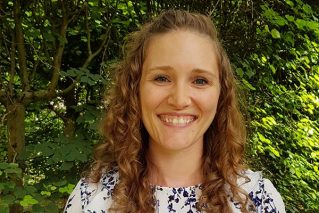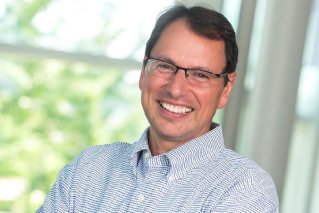Presumably there is no playbook on your bookshelf labeled, “Open in case of Global Pandemic.” What have you learned to-date about moving your business forward in the face of an exceptionally disruptive ‘black swan’ event?

Marcus Remmers, Chief Technology Officer, DSM
First and foremost, your employees’ well-being should be at the heart of every decision that you make – and never compromise on this! Business continuity cannot be more important than people’s health and safety. Period. But also the needs and worries of your people should be addressed from the start of the crisis; for example, the growing loneliness people tend to feel as a result of working from home for weeks in social isolation. Only by caring deeply and consistently about your people can you navigate effectively through this storm and ensure a robust and engaged workforce for the future.
And the future is something that can easily be overlooked in times of a crisis. While fighting short term challenges, you should also paint a vision for your employees on how reality will look like once the storm has passed. It’s important to reassure people that leadership is also looking at the overall health of the company over the long run. This will allow worried employees to free up mind space and focus on contributing their specific talents and skills to help fight the crisis at hand. It is leadership’s task to give people and teams direction, but to give them the freedom and trust to operate with speed and (a certain amount of) autonomy. To make this happen, you will have to push organizational agility and digital ways of working to the max – allowing people to effectively connect with one another remotely.
For all the above, the most crucial element is communication. Leadership at all levels should be visible and close to its people – particularly if it has to be in a virtual environment. Ensure that you have efficient two-way communication: senior leadership from across the organization shares one consistent message AND listens at the same time to the evolving concerns of the organization. Furthermore, ensure that the crisis team is on top of the external news and responds fast with updates on what those developments mean for the company. It’s crucial to avoid that a vacuum arises in which employees can make up their own stories, and rumors can spread.
Lastly: Look for ways in which you can turn the situation into an opportunity to help where you can– particularly if there are ways how you can leverage the assets of the company to help. For example, in DSM we were asked by the Dutch government for 130,000 liters of disinfectants to avoid a national shortage to fight the pandemic. With dedicated creative teams we have been able to create additional manufacturing capacity at a factory that normally produces resins to produce large quantities of disinfectants and donated these free-of-charge, to be distributed by the government to hospitals and health care facilities in the Netherlands. We are ready to produce more if needed.

Charlotte Allerton, Head of Medicine Design, Pfizer
In the face of this unprecedented healthcare challenge, the well-being of our colleagues, their families and the communities in which they live and work has been a key priority. With this at the forefront of our thinking we are trying, wherever possible, to continue our important work to bring needed medicines to patients. In particular, there is of course an overwhelming urgency to find preventative vaccines and therapeutics to tackle the SARS-CoV2 virus that is causing such disruption in our world.
In these times, I am reminded once again of the courage, passion and dedication of our colleagues at Pfizer who are committed to making a difference. Collaboration across industry, academia and regulatory agencies is critical to making progress, and it is heart-warming to see the doors that open when so many talented colleagues have a “make it happen” mindset. Through this mindset, Pfizer created and is progressing a 5-point plan directed to combating COVID-19 by working urgently on some approaches ourselves, while also looking to facilitate the work of others, both in an effort to expedite medicines to patients.

Vijay Swarup, Vice President of Research and Development, ExxonMobil
The quick rise and spread of COVID-19 around the globe has shown us just how interconnected we have become as a planet. Our new reality, however long it lasts, represents big changes to our lives. First and foremost, the health and well-being of our employees, their families and our communities, will always remain the top priority for our company. With many of us working from home and all of us experiencing the stress of the unknown, we have the opportunity to come together to collaborate and improvise.
Through World Wars and natural disasters in the past century, ExxonMobil is no stranger to adversity. We have faced extraordinary challenges before, throughout which we’ve stayed committed to our core principle – “protecting tomorrow today.” Energy powers our world, supplying every sector from agriculture to transportation to digital technology. The masks, gloves, syringes and packaging that the medical world is putting to use in full force now were all made possible by the chemistry that our researchers, engineers, and partners meticulously developed over the years.
At a time like this, I am grateful for all of our healthcare professionals on the frontlines, combatting the invisible enemy. And, as I remind our 2000-strong researchers and scientists across the world, I am grateful for and proud of each of you. Whether we are at the bench or by our laptops at home, we will continue to push the research, analysis, and discoveries that safeguard our future in the long-run. The call on our organization has never been greater—now more than ever, the world needs our resilience, our innovation and our collaboration to provide the energy needed to survive and to thrive.

Alexa Dembek, Chief Technology and Sustainability Officer, DuPont
During any crisis – I have a motto: put people first. It is the perspective I need to ensure I am doing right by my organization. In a crisis, the complexity can often be staggering. And we have not faced a crisis as multifaceted as COVID-19 in generations. We are making difficult decisions on multiple fronts, 24/7. Put. People. First.
So how does that play out? When the world was just waking up to the situation in China, we took immediate action to protect our workforce while ensuring business continuity and our production capabilities. In our case, we supply a first line of defense for health workers – Tyvek®, which is used in the protective garments used by medical professionals fighting this virus.
As the coronavirus expanded globally, we realized quickly that we needed to adapt to face an ever-changing reality. In Italy, we leveraged the same principles learned in China with a different culture and government context. And so on. For every region - we deal with different government requirements, customer needs, infrastructure capabilities, healthcare context, and customs. So, while we have a control center to support our businesses and regions in corporate, we also empower local leadership to take actions that support their teams —and encourage sharing of best practices with the rest of the world in real time. It is how we are moving the business forward in a rapidly evolving situation.
Now, as we are mobilizing the U.S., we are adhering to our core values, staying focused on what matters, taking care of our people and making every effort to bring our science to bear in service of fighting this pandemic. Every decision this week will be guided these principles – helping us to be our best, even when we are facing unprecedented challenges as a business and as individuals. By putting people first, I gain clarity. It helps me to simplify and focus on what really matters – each other.

Wendy Young, Senior Vice President of Small Molecule Drug Discovery, Genentech
One of the most important things we’ve learned is something we already knew: that Genentech employees are creative, resilient and mission-focused. It is in our DNA as scientists to be action-oriented and to come together as teams to solve problems.
Leaning on our basic principles of science, patients and people offered immediate clarity in this stressful and unpredictable situation. Ensuring the safety of our employees and local communities, while continuing to deliver medicines to patients who need them, has remained our focus. Everyone has rallied around these principles and moved into action – whether it’s rethinking how to continue a lab experiment remotely or implementing new measures to ensure continuity of our drug supply. It has been heartening to see everyone perform at their very best under these incredibly challenging circumstances.
We also knew that transparent and open communication would be key to relieving anxieties while maneuvering through uncharted territory. Thank goodness for the myriad of modern communication tools at our disposal today to connect people in our community regardless of where they are located around the globe.
Last week, our senior leaders held a company-wide teleconference allowing all of our 13,500 people to connect and ask questions. With both strength and compassion, our leadership acknowledged every important issue that employees raised, whether there was a solution already in place or not. We’ve heard from employees that this candor was critical in showing that our leadership truly cares, and in helping to keep people as calm and focused as possible in this time of uncertainty.
Another learning for everyone involves new ways of doing our work. As of this writing, the majority of our employees are working from home to “flatten the curve” (i.e., reduce potential exposures), with access to all Genentech U.S. sites limited to people who need to be on site to carry out essential biotech business continuity activities. This dedicated group on site is working around the clock to maintain our supply chain so our patients get the medicines they need.
For our earlier stage drug discovery work, our teams are getting extra creative and resourceful in figuring out how to keep programs moving without active hands in labs in South San Francisco – including engaging our highly skilled partners around the globe. Between our partners stepping up and our Genentech teams being agile, we’re doing everything we can to continue our drug discovery efforts through this period in order to deliver the next generation of transformative medicines.
Finally, this unprecedented situation has brought into sharp focus what is most impactful in the invention of new medicines and is teaching us how to bypass processes that are not directly supporting our ability to bring these novel medicines to patients. I am confident that new ideas and better ways of working will emerge from the way Genentech employees are rising to meet this challenge.
"A diamond is a chunk of coal that did well under pressure." – H. Kissinger
The opinions expressed in this article are the author's own and do not necessarily reflect the view of their employer or the American Chemical Society.
Copyright 2020 American Chemical Society (All Rights Reserved)










